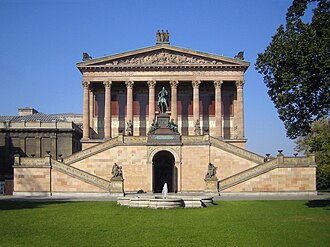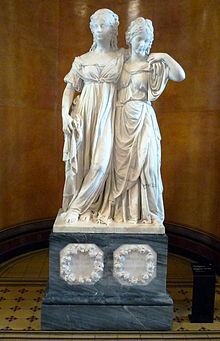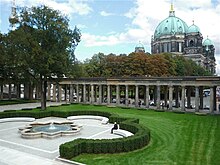Old National Gallery

The Alte Nationalgalerie in Berlin district of Mitte is part of the architectural ensemble of the Museum Island and the World Heritage Site of UNESCO . Planned by Friedrich August Stüler on behalf of King Friedrich Wilhelm IV from 1862 onwards , it was executed by Johann Heinrich Strack in the classicism and neo-renaissance style until 1876 . It is currently home to paintings and sculptures from the 19th century from the collection of the National Gallery . On the steps is that of Alexander Calandrelli created equestrian statue of Frederick William IV.
In 2019 the Alte Nationalgalerie recorded 376,000 visitors.
description
location
The Old National Gallery, together with the Old Museum , the New Museum , the Bode Museum , the Pergamon Museum , the James-Simon-Galerie , the Berlin Cathedral and the Lustgarten form the complex of the Berlin Museum Island . It is located in the middle of the island, between the tracks of the Berlin Stadtbahn and Bodestrasse, on the eastern bank. The Pergamon Museum connects to the west, the Neues Museum, the Old Museum and the Berlin Cathedral to the south.
architecture
The building of the Alte Nationalgalerie combines architectural elements of different building types. The gable facade and the surrounding half-columns are borrowed from a temple , the monumental staircase from a castle or theater and the attached apse from a church . In this combination, the building should architecturally emphasize the unity of nation, history and art. In addition to the flight of stairs, the Alte Nationalgalerie used to be accessible at ground level via a carriage passage. On the outside staircase is the bronze equestrian statue of Friedrich Wilhelm IV with the base figures "Religion", "Art" (poetry), "History" (history) and "Philosophy", created between 1875 and 1886 by Alexander Calandrelli based on a design by Gustav Blaeser .
With the first floor of the exhibition in the rusticated base, the basement provides the desired height effect of the temple. Above this is the second, nobler exhibition floor. This is indicated on the facade by attached half-columns. In addition, both floors have high windows that also shape the facade. The third exhibition floor, on the other hand, cannot be recognized by its facade. This floor receives daylight through a glass ceiling. The facade and the external staircase are made of Nebra sandstone ( Triassic ); the colonnades made of Silesian sandstone and Elbe sandstone (both from the Cretaceous period) . Stylistically, the building stands between the late Berlin classicism and the beginning neo-renaissance . The exterior of the museum was retained in its original state, while the interior was changed several times during renovation work and renovations and adapted to the requirements of the exhibition.
history


Emergence
As early as 1797, Friedrich Gilly had planned a temple with colonnades for a monument in honor of Frederick the Great . With this he influenced the architecture in Berlin in general and especially that of his pupil Karl Friedrich Schinkel . He dreamed of building a group of temples in a landscape. Crown Prince Friedrich Wilhelm IV of Prussia , who was Schinkel's student of architecture and conversational partner, made the first sketches inspired by this, which formed the basis for the building of the Alte Nationalgalerie.
The first ideas to set up a national gallery emerged around 1815 and intensified in the 1830s. However, they did not include a building of their own. In 1841 the first concrete plans to set up the National Gallery came up, but were not subsequently implemented. That year there was also a plan by Friedrich August Stüler that a temple should be built north of the Altes Museum. However, it did not get beyond the preliminary stage and was not further specified.
In 1861 the banker Joachim Heinrich Wilhelm Wagener died . He left an extensive collection of paintings as a donation to King Wilhelm I of Prussia , combined with the wish that the collection should be "kept undivided" and "set up here in Berlin in a suitable location and always made available to all artists and art lovers". Wilhelm I accepted the donation. This provided the basis for furnishing a national gallery. In the tradition of his predecessor, Wilhelm I let Schinkel's student, Friedrich August Stüler, continue to work on the plans. The Wagener painting collection was temporarily shown to the public as Wagenersche and Nationalgalerie in the rooms of the Akademie der Künste Unter den Linden until 1876 .
Planning and construction
Friedrich August Stüler began planning the National Gallery building in 1862. Stüler's plans in 1862 included the Academy of Arts and artist studios . As a result, the plans were further revised, but the main features of the building that was realized later could already be seen in them. Above all, this should house a gallery in which contemporary art should be shown. Two years later, Stüler presented the third plan, which was also approved. In 1865, after Stüler had died, the details were worked out by Carl Busse .
Stüler and, after his death, his successor Johann Heinrich Strack planned many of the details of the building in great detail. For example, when planning the cornice, the profiling, the effect of light and shadow, the volume, the lines, the material and the color were coordinated very precisely. The execution drawings indicate each dimension and also the manufacturing technology. Another example of the exact planning are the doors, which varied from floor to floor. The door leaf and the reveal were varied with many small elements, even if they were only drafts for secondary rooms in the museum.
In 1866, according to a royal cabinet order, the commission for the construction of the National Gallery was set up to accompany the construction. After older buildings that were on the site, including the old orangery house and the so-called Welper bathing house, had been demolished, the foundation stone was laid in 1867 and construction began.
The construction took place under the direction of Johann Heinrich Strack. The roof structure was completed in 1872 and the interior work began. The opening of the museum building took place on March 22, 1876 in the presence of the emperor. The building was praised as fire-safe due to the modern iron structures and brick ceilings. Together with the large-scale roof glazing, which was only possible for a short time, the museum represented the state of what is structurally possible.
Destruction and rebuilding
After Adolf Hitler came to power in 1933, Ludwig Justi was deposed as director of the National Gallery. He was followed by Eberhard Hanfstaengl , who held the post until 1937. He also planned further museum redesigns and had several renovations carried out. He was succeeded by Paul Ortwin Rave , who remained director until 1950. When the Second World War began in September 1939 , the National Gallery was closed.
During the Second World War, the building of the National Gallery was badly damaged by bombing, shelling and ground fighting towards the end of the war. It has not yet been clarified which works of art were destroyed during this time and which ended up in the Soviet Union as looted art . The Museum Island was now in the Soviet sector of Berlin.
As early as 1945 the first efforts were made to get money for the reconstruction of the National Gallery building. In 1946, Justi took over the management of the former state museums as general director . In 1947, the clearing work began, in 1948 the reconstruction. In 1949, parts of a building on Museum Island in the National Gallery were made accessible to the public again. By 1955, all showrooms had been rebuilt. In them, the works of art of the 19th century were exhibited together with contemporary art. The rest of the restoration work on the building was completed by 1966.
In the espionage film The Torn Curtain (1966) by director Alfred Hitchcock , the museum was the setting for some essential scenes, but only as mock-ups, as no filming permission was obtained.
In the course of the German division , the collection of the Nationalgalerie was also divided between East and West according to the relocation locations. Important works in West Berlin were initially exhibited in the orangery of Charlottenburg Palace and from 1968 in the Neue Nationalgalerie , a new building at the Kulturforum . In 1986 part of the exhibition was relocated to Charlottenburg Palace as the Gallery of Romanticism .
Reunification and redevelopment
After German reunification , the collection, which had previously been divided between East and West, was brought together again, and the works from the 19th century returned to Museum Island . The National Gallery , which was previously located in East Berlin , was now called the Old National Gallery - the New National Gallery in the former West Berlin was opened in 1968.
Although planned since the 1980s, the necessary general overhaul was not carried out during the GDR era . Only work that could not be postponed and minor restorations had been carried out. After the German reunification, the existing plans for general renovation were revised in 1990 and included in the deliberations on a museum concept for all the State Museums in Berlin . Most of them have been confirmed, but adapted to the most modern technical possibilities. In the following year, the utmost urgency of the redevelopment was determined.
From 1992 restoration and refurbishment work was carried out on the outside of the building. The redesign of the entrance area, the installation of two halls for the works of Caspar David Friedrich and Karl Friedrich Schinkel as well as the integration of the building technology required by today's standards were the most important tasks in the context of the general renovation, for which the German architect HG Merz was responsible. In 1998 the museum closed for work inside the building. On December 2, 2001, the Old National Gallery was reopened as the first building on Museum Island.
After Bernhard Maaz (2003–2009) and Philipp Demandt (2012–2016), Ralph Gleis has been running the house since May 2017 .
Collections

Previous collections
Max Jordan was the first museum director to take office in 1874 . When it opened in 1876, the National Gallery had relatively few works. The foundation was formed by the collection of the banker Joachim Heinrich Wilhelm Wagener , consisting of 262 paintings by German and foreign artists, which had previously been housed in the rooms of the Academy of the Arts . In addition to the Wagener painting collection, only a collection of cardboard boxes by Peter von Cornelius that had been left to the Prussian state and which the Prussian state now wanted to house in a dignified manner was shown. The task of the Nationalgalerie was to collect modern, initially mainly Prussian art, as Berlin did not have a museum for contemporary art at that time.
In 1896 Hugo von Tschudi took over the position of museum director as the successor to Max Jordan. Tschudi acquired Impressionist art for the National Gallery. In doing so, he risked a conflict with the emperor, since the Nationalgalerie's focus on German art was thereby canceled.
After Ludwig Justi became Tschudi's successor in 1909, he expanded the collection to include expressionist works of art. Justi exhibited modern art in the Kronprinzenpalais after the November Revolution . Since then, a distinction has been made between the National Gallery I and the National Gallery II .
Today's collections
The Alte Nationalgalerie shows the most important works of the 19th century from the collection of the Nationalgalerie Berlin . On the first floor of the exhibition, classicist sculptures and “ways of realism” are shown, including sculptures by Johann Gottfried Schadow , Christian Daniel Rauch , Antonio Canova and Ridolfo Schadow , paintings by John Constable , Gustave Courbet and the Barbizon School as well as - in the rear transverse hall and the apse cabinets - Adolph Menzel's paintings such as The Balcony Room (1845), Frederick the Great's flute concert in Sanssouci (1852) and Eisenwalzwerk (1875).
Works from Romanticism, Realism and Impressionism are shown on the second floor of the exhibition. This includes works by Carl Spitzweg , Arnold Böcklin , Hans von Marées and Anselm Feuerbach . There are also works of French impressionism such as Im Wintergarten , Landhaus in Rueil and Der Fliederstrauss by Édouard Manet , The Church of Saint-Germain-l'Auxerrois , Houses in Argenteuil , View of Vétheuil and Meadow in Bezons by Claude Monet , In Summer by Pierre- Auguste Renoir , as well as pictures by Edgar Degas and Paul Cézanne . There are also works by the German impressionists by Max Liebermann and Lovis Corinth and the sculptures by Auguste Rodin .
Works from the Goethe era and Romanticism are shown on the third floor of the exhibition. These include works by Caspar David Friedrich , Karl Friedrich Schinkel , Carl Blechen , the Nazarenes (including Peter von Cornelius , Friedrich Wilhelm von Schadow and Friedrich Overbeck ). The so-called group of princesses , a double statue, is exhibited by the sculptor Johann Gottfried Schadow . Next to it you can find the marble tomb of Count Alexander von der Mark from 1790, also created by Schadow , which was originally in the Dorotheenstädtischen church . After this was destroyed in the Second World War, the parish gave it to the Alte Nationalgalerie as a permanent loan .
Caspar David Friedrich:
The Monk by the Sea (1808–1810)Friedrich Overbeck : Sale of Joseph to the Egyptian dealers , cycle of frescoes by Casa Bartholdy (1816–1817)
Carl Friedrich Lessing :
The Hussite Sermon (1836)Édouard Manet :
In the Winter Garden (1879)Pierre-Auguste Renoir:
In the Summer (1868)Adolph Menzel: iron rolling mill (1875)
Carl Spitzweg :
Flying a kite (1880–1885)
Exhibitions
Special exhibitions at the Alte Nationalgalerie often attract over 100,000 visitors, most recently Wanderlust. From Caspar David Friedrich to Auguste Renoir (2018), Gustave Caillebotte. Painter and patron of impressionism (2019) and the struggle for visibility . Artists of the Nationalgalerie before 1919 (2019). With 245,694 visitors the exhibition was Impressionism - Expressionism. Kunstwende in 2015 was the most successful show ever held in the Alte Nationalgalerie. In 2019 the Alte Nationalgalerie broke new ground with the digital mediation offer With the Monk by the Sea : Visitors were able to experience one of the key works of the collection, The Monk by the Sea by Caspar David Friedrich, via a virtual reality application.
See also
literature
- Bernhard Maaz (Ed.): The Old National Gallery. History, construction and remodeling. G + H, Berlin 2001, ISBN 3-931768-58-9 .
- Peter-Klaus Schuster : The Old National Gallery. DuMont, Cologne 2003, ISBN 3-8321-7370-6 .
- Angelika Wesenberg , Sigrid Achenbach (conception and implementation): France in the National Gallery. Jütte-Messedruck, Leipzig 2007, ISBN 978-3-88609-585-8 .
- Udo Kittelmann , Birgit Verwiebe, Angelika Wesenberg (eds.): The collection of the banker Wagener. The foundation of the National Gallery . EA Seemann Verlag, Leipzig 2011, ISBN 978-3-86502-274-5
- Bénédicte Savoy , Philippa Sissis (ed.): The Berlin Museum Island: Impressions of international visitors (1830–1990). An anthology. Böhlau, Vienna / Cologne / Weimar 2012, ISBN 978-3-412-20991-9 .
- Angelika Wesenberg, Birgit Verwiebe, Regina Freyberger (eds.): Painting in the 19th century. The collection of the National Gallery . Inventory catalog. Imhof Verlag, Petersberg 2017, ISBN 978-3-7319-0458-8 .
Web links
- Internet pages of the Staatliche Museen zu Berlin: Alte Nationalgalerie
- Online catalog of the Alte Nationalgalerie
- Association of Friends of the National Gallery
- Publications from or about the Alte Nationalgalerie in the catalog of the German National Library
- Old National Gallery in the German Digital Library
- Search for Alte Nationalgalerie in the SPK digital portal of the Prussian Cultural Heritage Foundation
- The Alte Nationalgalerie in the Google Art Project
- Entries in the Berlin State Monument List with further information:
Individual evidence
- ↑ Alte Nationalgalerie, Staatliche Museen zu Berlin, Berlin, Germany. Retrieved May 7, 2020 .
- ↑ Berlin State Museums counted more than 4 million visitors in 2019. January 31, 2020, accessed July 19, 2020 .
- ^ A b Claude Keisch (Ed.): The Old National Gallery Berlin . Scala Publishers and Beck, London and Munich 2005, p. 7.
- ↑ a b Bernhard Maaz (Ed.): The Old National Gallery - History, Construction and Reconstruction. G + H, Berlin 2001, p. 52.
- ↑ a b Bernhard Maaz (Ed.): The Old National Gallery - History, Construction and Reconstruction. G + H, Berlin 2001, p. 49.
- ↑ Bernhard Maaz (Ed.): The Old National Gallery - History, Construction and Conversion. G + H, Berlin 2001, p. 50.
- ^ Berliner Morgenpost - Berlin: Philipp Demandt new director . ( Morgenpost.de [accessed on July 21, 2017]).
- ^ Ingeborg Ruthe: Museum Island: A Westphalian for the Old National Gallery . In: Berliner Zeitung . ( berliner-zeitung.de [accessed on July 21, 2017]).
- ^ National Museums in Berlin: Already 150,000 visitors to 'Wanderlust'. Retrieved May 6, 2020 .
- ^ National Museums in Berlin: Already 100,000 visitors to “Gustave Caillebotte”. Retrieved May 6, 2020 .
- ^ National Museums in Berlin: 125,000 visitors * in the exhibition "Struggle for Visibility". Retrieved May 6, 2020 .
- ^ National Museums in Berlin: Around a quarter of a million visitors - ImEx closes with record results. Retrieved May 6, 2020 .
- ↑ With the monk by the sea. In: Website of the Alte Nationalgalerie. Retrieved July 18, 2020 .
Coordinates: 52 ° 31 '15 " N , 13 ° 23' 53.8" E












